
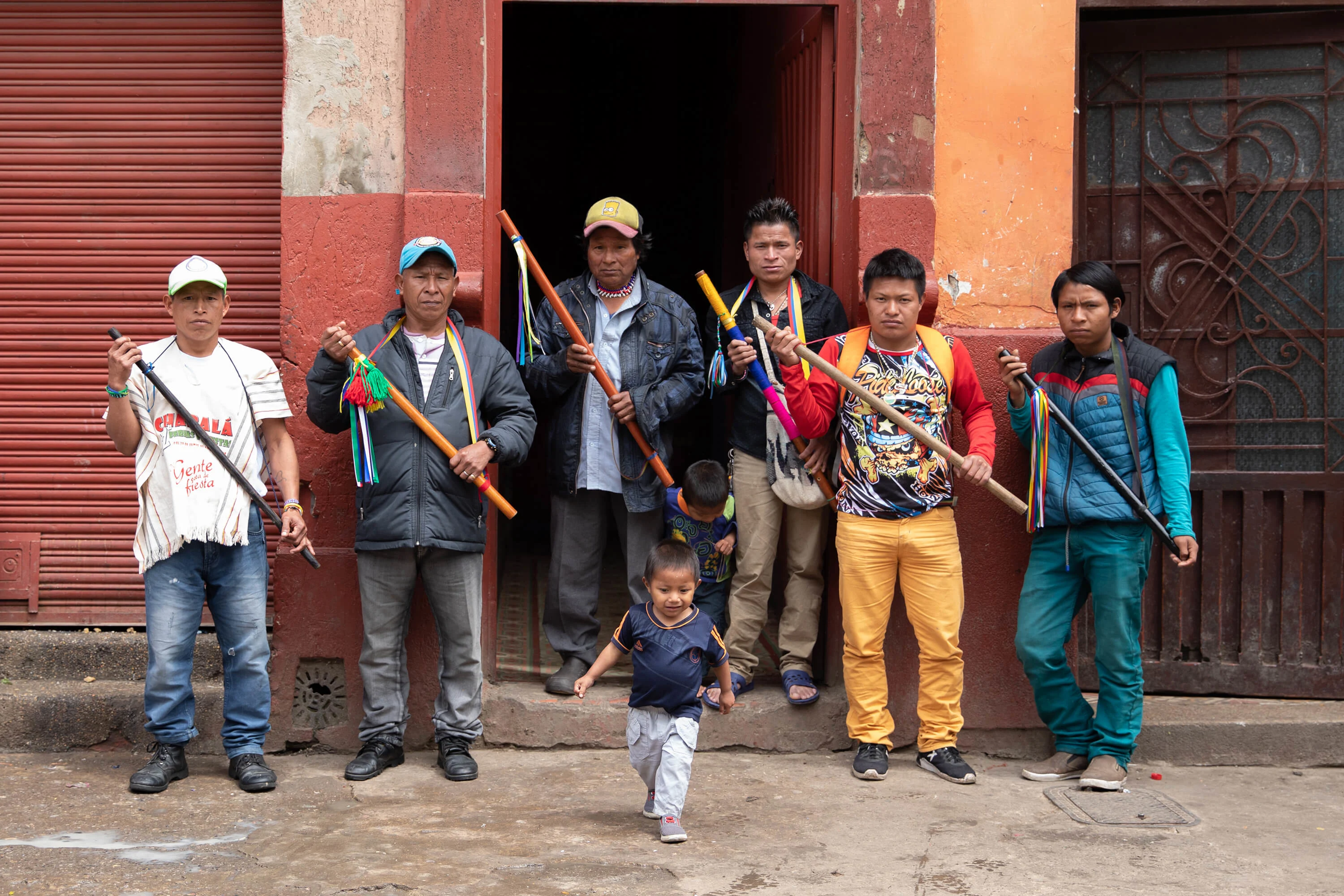
For hundreds of years the indigenous Embera people of Colombia have faced persecution, structural racism and displacement. In this account of heartache, murder, protest and finally freedom, photojournalist Tomas Ayuso follows their journey back home.
Fernando Marukama never thought he’d be a leader. A decade ago he lived a simple life as a farmer in one of the more secluded Embera communities that dot Western Colombia. At least that was the case until 2006, when the conflict that had been raging around the country for fifty years visited his village.
The swampy riverlands surrounding his home filled up with military in pursuit of guerrilla groups. The rebels encamped nearby demanding material support for their cause, thrusting the indigenous Embera forcefully into a war that wasn’t theirs. For this Fernando nearly paid in blood when a military gunboat strafed his home, wounding him and shooting him through the abdomen believing he was a guerilla.
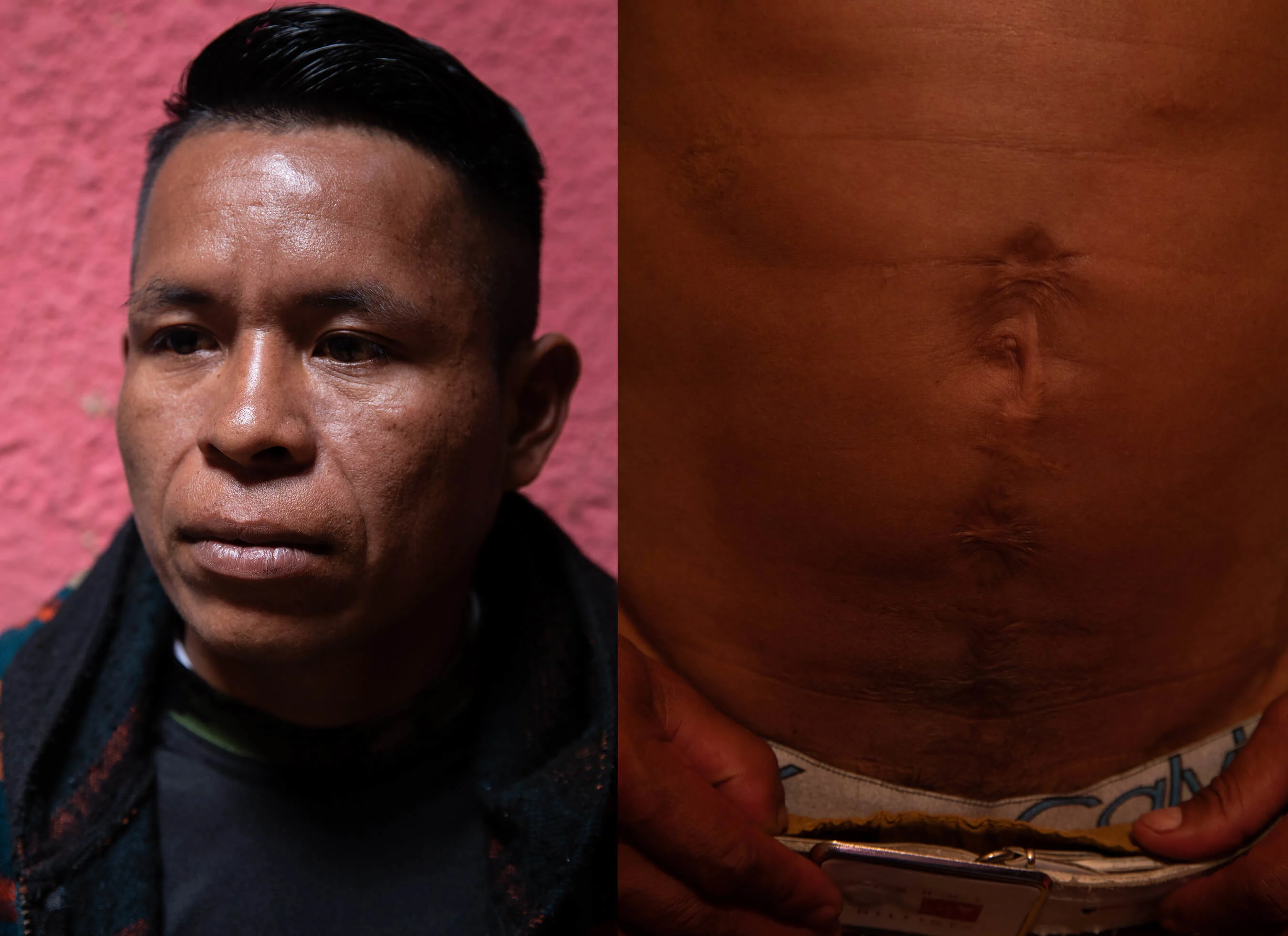
Military intelligence had marked the village as part of the insurgency. They were wrong; often the case in the waning years of the conflict. Skirmishes between armed groups in the departments of Choco and Risaralda depopulated Embera communities during a ten-year period from 2006-2015, and with the peace accord not coming into effect until 2016, Fernando wouldn’t wait for the fighting to return. As soon as he recovered, he packed a bag and fled to Bogota. Along with 1500 other Embera who eventually left for the capital in the years that followed, Fernando became another one of the 7.7 million internally displaced Colombians the conflict left in its wake.
With little money and no friends in the big city, Fernando and his community bounced around from shelter to shelter. They soon found out the state didn’t have infrastructure to support 1500 people in their victims of war housing. Promising that their displacement would be only temporary, the local and national governments encouraged them to find spaces on their own. They looked for an inexpensive option, close to government offices, that could house hundreds of their own who were still homeless. A tall order. In turn, what they found was misery.

San Bernardo
In the gang-controlled neighborhood of downtown Bogota - the San Bernardo - the Embera found living spaces in four graffiti-covered rent-per-day tenement buildings known as paga-diarios (pay daily). Essentially flophouses, the paga-diarios are crumbling turn of the century apartments, partitioned endlessly into smaller and smaller rooms which several families could share to sleep, cook and live in. For 20,000 pesos a night ($6.60 USD) the hundred or so Embera in each building had two communal bathrooms, and slept on pads on the floor.
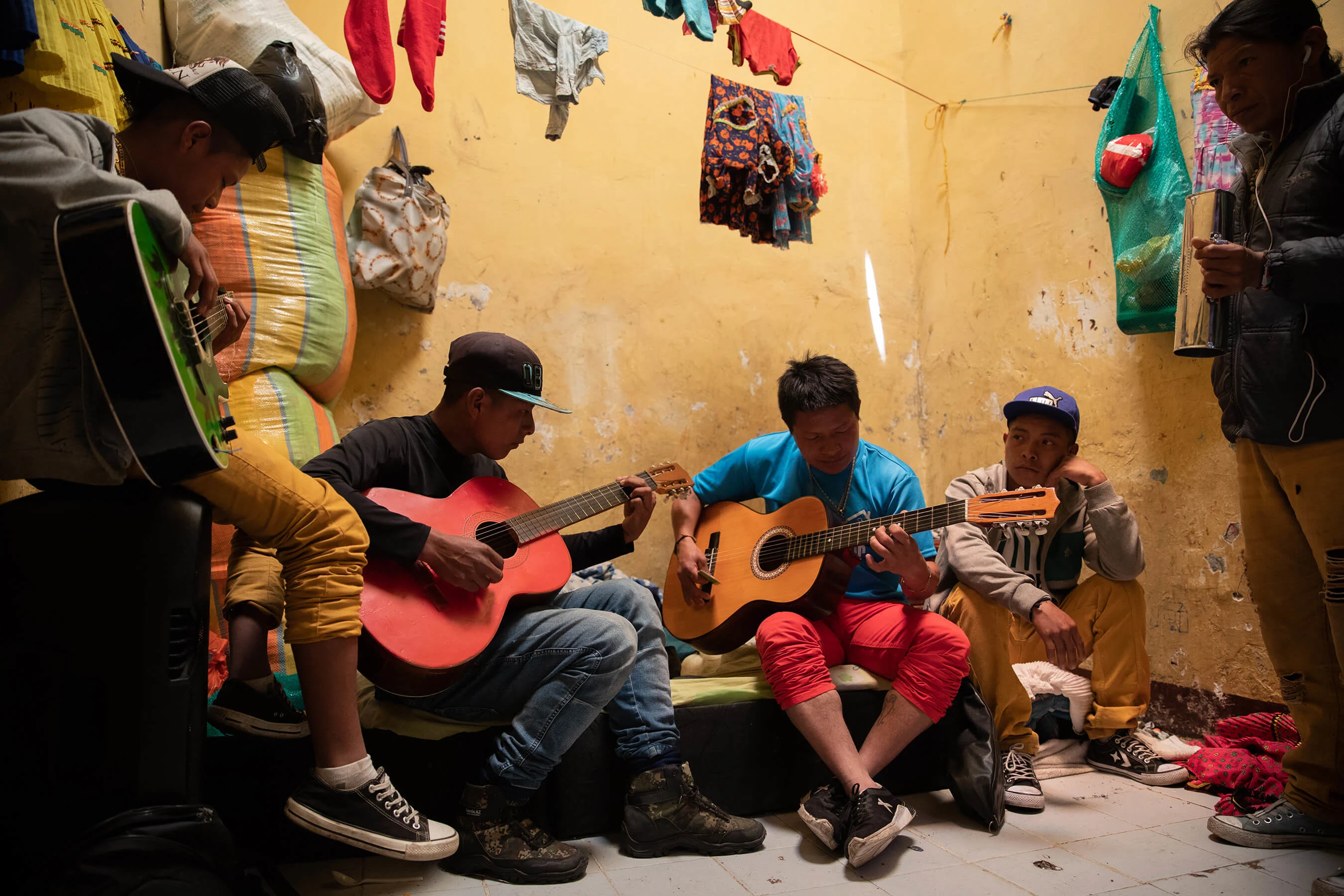
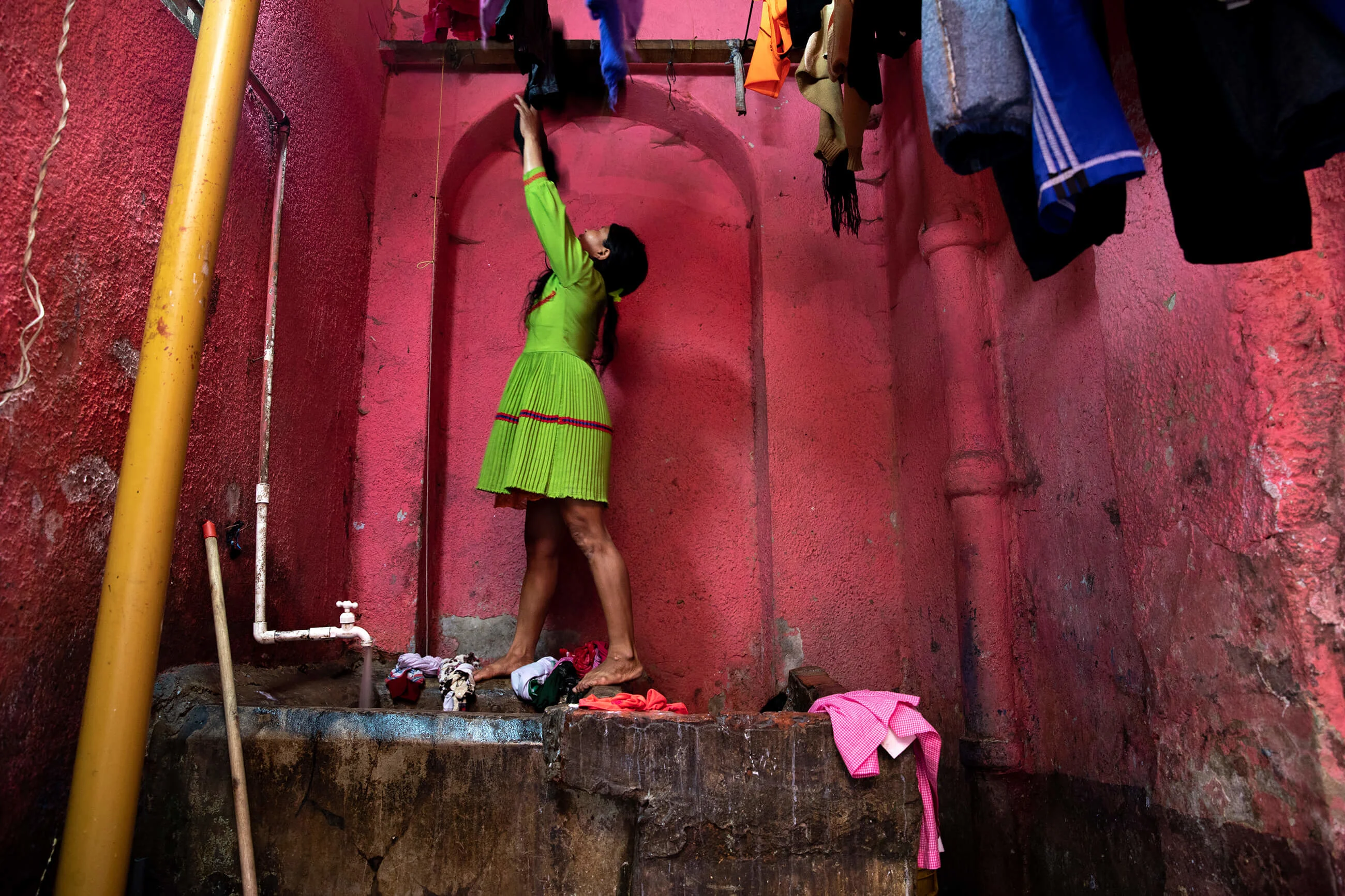
The claustrophobic hallways that connected the rooms, echoed with music played on busted cellphone speakers, the desperate wailing of newborns, and conversations in Embera. During the mornings at the paga-diario women hung their traditional dresses to dry on every available space, children played football in the halls and men headed to work. At sundown the families rushed back to the building and locked themselves in; at night the streets of San Bernardo turned hostile.
Ever since moving to the neighborhood in late 2006, the Embera were once again victimized by new oppressors: their neighbors. Hostile gang members pushing bazuco (a byproduct of cocaine production) and addicts looking for a fix, harassed and abused the displaced families because they were indigenous. Police seldom patrolled the area, leaving the Embera to fend for themselves. People were robbed, elders beaten, and youth recruited into dealing. Over the course of a decade, tensions mounted as the community began to organize.

William
In August 2018, over a decade since the first Embera moved to San Bernardo, William Nari hummed a lullaby to soothe his daughter, Soledad, to sleep. An ear infection drove the infant into a howl that kept everyone in the building up all night. William shared the tiny alcove with his brother, wife, child and in-laws. They made do with the space they had but the lack of sleep, persistent unemployment and the pressure of the streets was getting to William.
He cradled the infant in his tattooed arms, covered in traditional glyphs for good fortune. The racism he faced on the city streets didn’t bother him. After all, William said, the Embera looked after each other. They lived under the principles of indigenous self-defense and were always ready. William and his brother kept their traditional clubs nearby. It was the threat of violence from his neighbors that put him on edge.

A week prior, William’s brother was walking home when gang members started following him. The men hurled anti-indigenous slurs and taunted him with violence. The young Embera man didn’t cow to the vitriol, instead enraging the gang members who gave chase with a machete. William and others heard the commotion and poured out of the building. They grabbed their clubs and beat the men back. After this fight the streets stayed permanently tense.
Still, for William the marauding threat outside wasn't his primary concern. The anguish that haunted most displaced Embera was figuring out where the day’s food and rent money was going to come from. Unable to find work, they improvised.
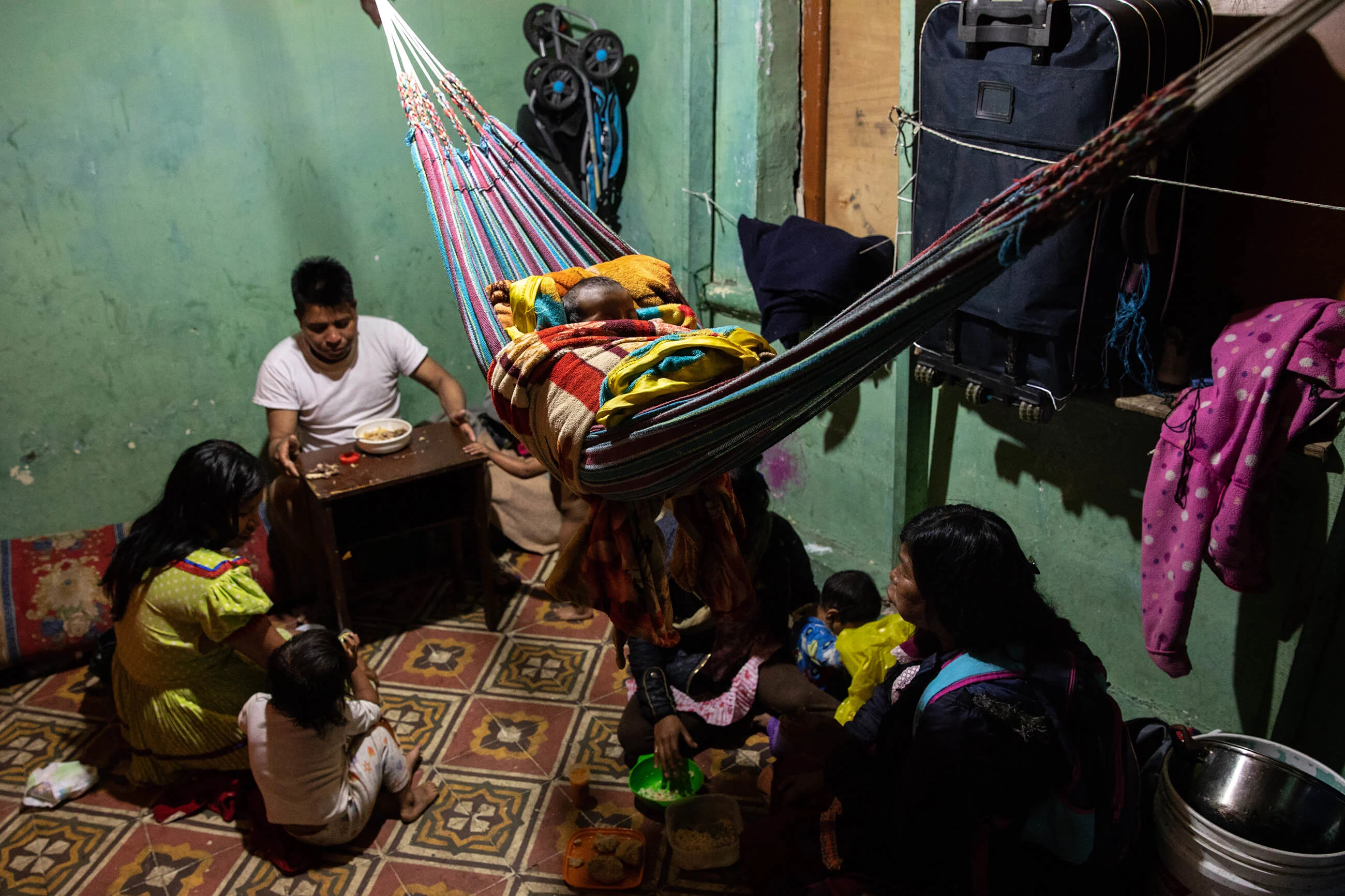
Work
In the same building as William, Mirian Estevez, an ailing widow with nine children, shared the same problem. She was the only one in her family who was able to earn money, but her deteriorating health reduced her to begging on the street like many other Embera. Rent was eight dollars a day, while food for the family was 13 dollars daily. Unable to speak Spanish, Mirian earned four dollars at best to split between expenses. To make ends meet, she shared the living space with a family of eight. Just in that one tiny room, 19 people slept on the floor. Even after they pooled incomes to keep a roof over their heads and eat at least one meal a day it wasn’t enough.
The people in the tenement felt trapped: they were told they would only be in Bogota temporarily. The displaced Embera believed that they wouldn’t suffer if they returned to their territories. Back home, they said, nature provided them with food, building materials and enough work to live a peaceful life. But they couldn’t go back while the conflict raged on. And they wouldn't anyway. As displaced indigenous people of Colombia, the Embera are constitutionally guaranteed protections and special consideration. Until the state ensured peace in their territories and honored their responsibilities, they refused to leave Bogota.

Miguel used to farm a grove with plantain and yucca he tended with his brother.
Even if the troubles of living in San Bernardo kept them up at night, the risk of returning to their ancestral lands was too great. And with good reason: every one of the displaced had been touched by the conflict, either directly or by the loss of a loved one. Miguel Sintua was at the Sunday market when a guerrilla commando fired hundreds of AK47 rounds into his village. They attacked as punishment for allegedly collaborating with the military. The incursion left his brother dead and Miguel wounded. Since then, Miguel suffered piercing pain in his thigh where the bullets were fused between his flesh and bone. Bogotá’s altitude and biting cold made his wound worse, and with every pang Miguel was reminded of the atrocity that took his brother five years ago.
Miguel’s circumstances forced him to learn how to embroider traditional Embera accessories for work. While others ran around the city looking for jobs, Miguel stayed home and watched other people make necklaces, known as okama, until he learned how to make them himself. Eventually he got good at it and his sister would sell them for 25 dollars a piece. “There’s good days and bad days. We just pray to God for more good days than bad,” said Miguel.
Miguel admitted it wasn’t the type of work he was accustomed to doing: he used to farm a grove with plantain and yucca he tended with his brother. But he admitted he learned to like it. Miguel designed each piece from his imagination, making each okama one of a kind. Some necklaces invoked the color schemes of the Embera cosmology, while others were reflections of his mood. Lately he’d been using bright reds and muted blues, Miguel explained: “These days I’m feeling stressed.”


History
Recognizing the issues the community faced during the time in the tenements, Fernando and other leaders began pressuring the state to return them to their territories. Government inaction lead to false promises, which resulted in suffering. It's in this way that Embera history is cyclical; they are free until conflict comes to them, Fernando explained.
The Embera first appeared as a distinct group when they left the Amazonian heartland tens of thousands of years ago. They roamed as hunter-gatherers along the Pacific coast of Colombia, across the Darien Gap and well into Panama. Eventually they settled into two different groups: Embera Katio, “people of the jungle,” and Embera Chami, “people of the mountain.” Both groups share customs and traditions even though their languages are mutually unintelligible. Once in their territory, the Embera developed into farming and fishing communities. Until the Spanish came.
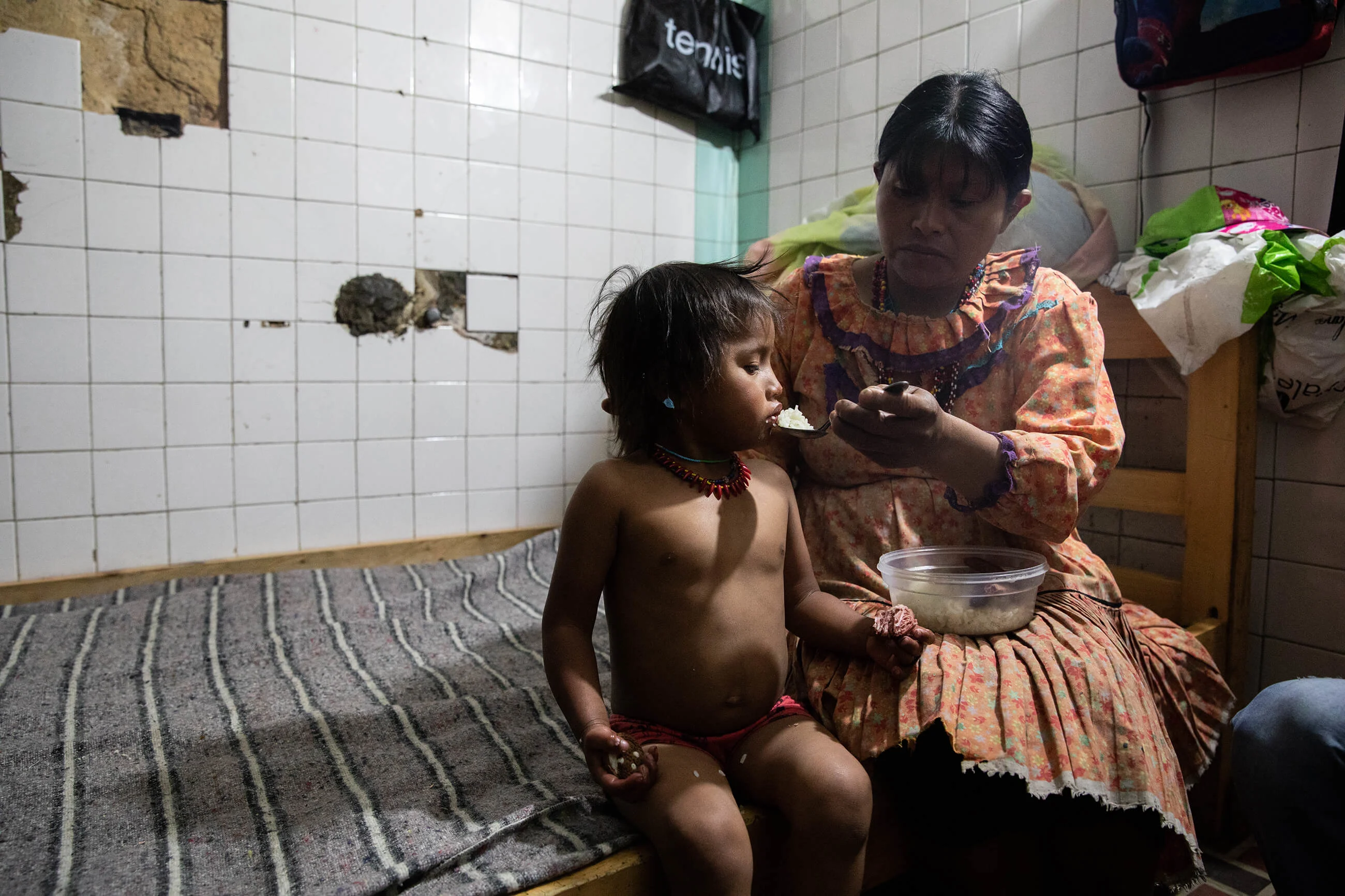
They feared tensions could boil over at any time and someone could get hurt.
During the conquest, they were chased into the swampy jungles of western Colombia and up into the Andes. Entire populations fled forced conversion, massacres, and dispossession that came with colonization. After independence the Embera were politically and economically marginalized by the nascent Colombian government. Structural racism and violence nearly destroyed their way of life as ancestral lands were taken from them in the name of progress. Years later the political violence coursing through the country would once again reach their communities.
The conflict brought with it armed groups that targeted, recruited and brutalized the Embera, while claiming to be fighting for their freedom. Instead, for the better part of three decades, the indigenous communities of Choco and Risaralda have been trapped between the military and the insurgency; forced to suffer war or become displaced. In their exile they didn’t receive the support the government promised and found themselves again in a similar situation: pressured on both sides by scarcity and the threat of violence from the streets.
Fernando and the other leaders worked tirelessly to secure any deal with the state as long as their situation improved. They feared tensions could boil over at any time and someone could get hurt. And their predictions turned out to be true.
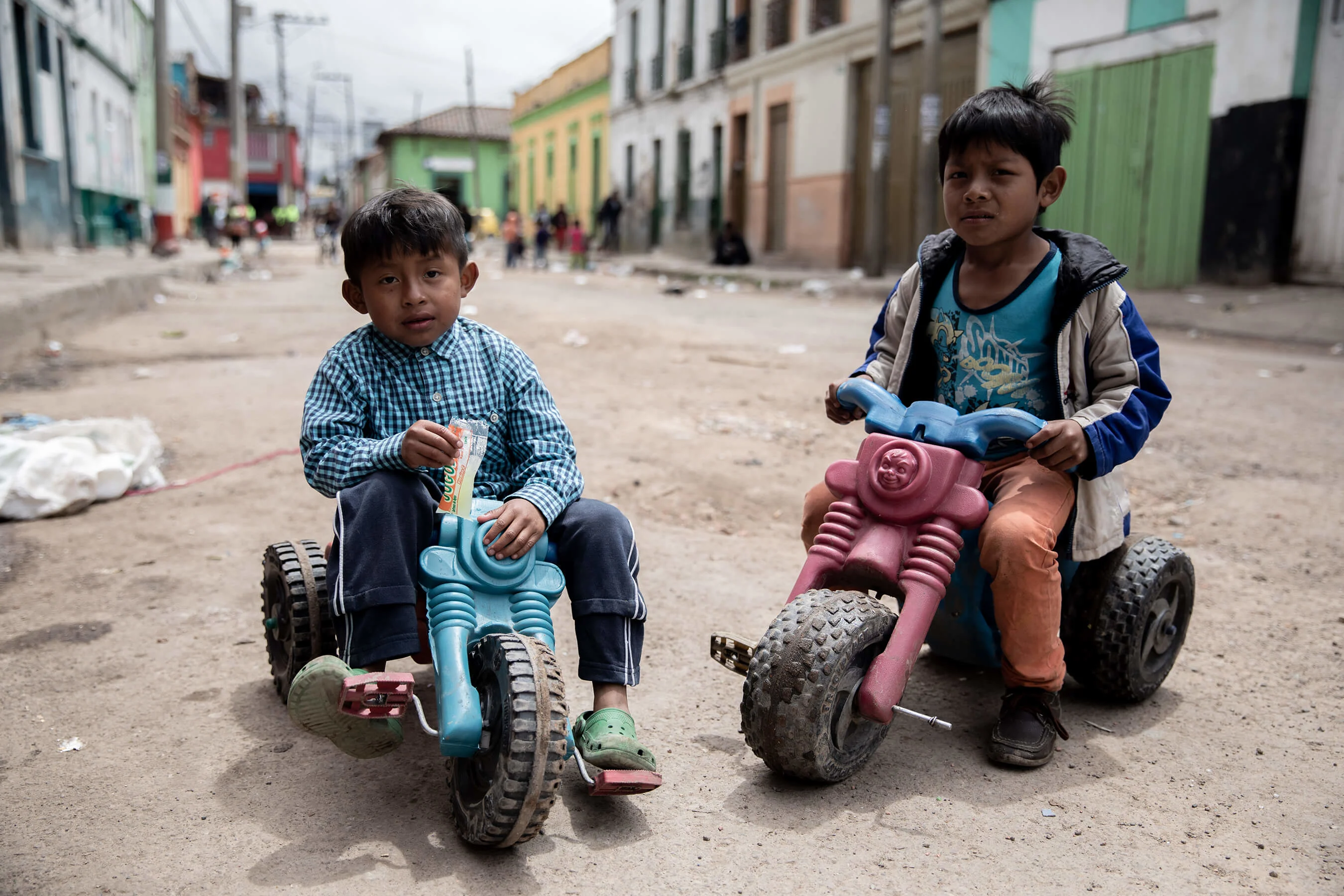
Murder
On the night of August 23 2018, Abelardo Sintua, was murdered by a gang member who gave him a soda laced with poison. An hour after he drank it he was found by his son convulsing on the floor. The boy yelled for his mother, Patricia, who was stitching okamas upstairs. By the time she ran down, her husband was already dead. For months the harassment towards the Embera from their new neighbors had been escalating, going from racist abuse to outright death threats, until they finally made their move.
When news of Abelardo’s death spread, an hours long melee erupted between gang members and the Embera. The police barely contained the rage as the neighborhood burned overnight. After the fight, Patricia took her children to another building. The family was forced once again to look for shelter, making them twice displaced: first to the conflict, and now to hate. Women in the tenement tried to console Patricia but she was catatonic. She took staggered breaths, and rubbed her sleeping children’s heads in a trance. Patrica repeated, “they killed my Abelardo,” as she wept.
Seeing this, the Embera leaders ensconced the community in the paga-diario for their own safety. Their demands crystalised then and there: the government had to provide safe shelter and finally secure their right to return to their territories.
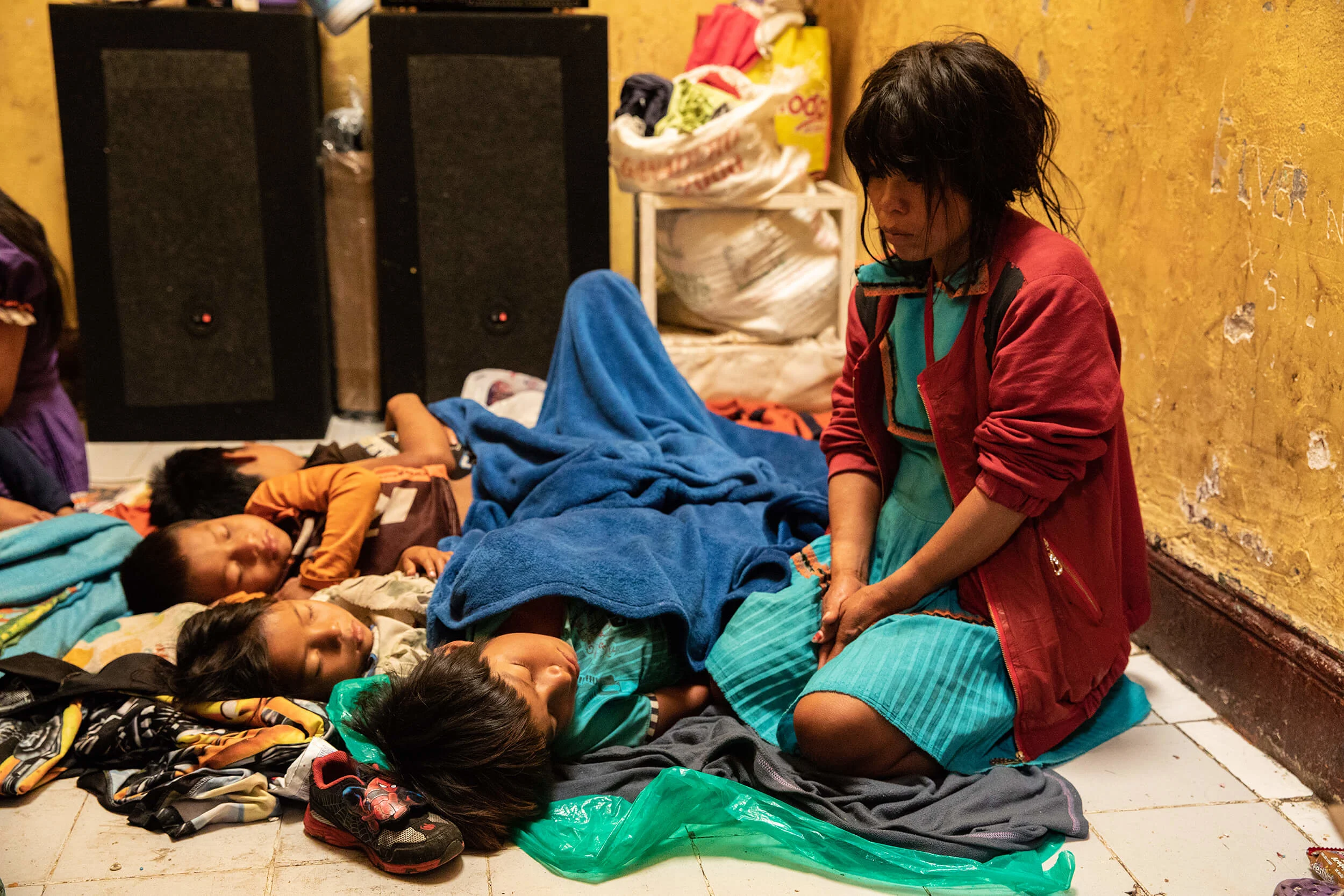


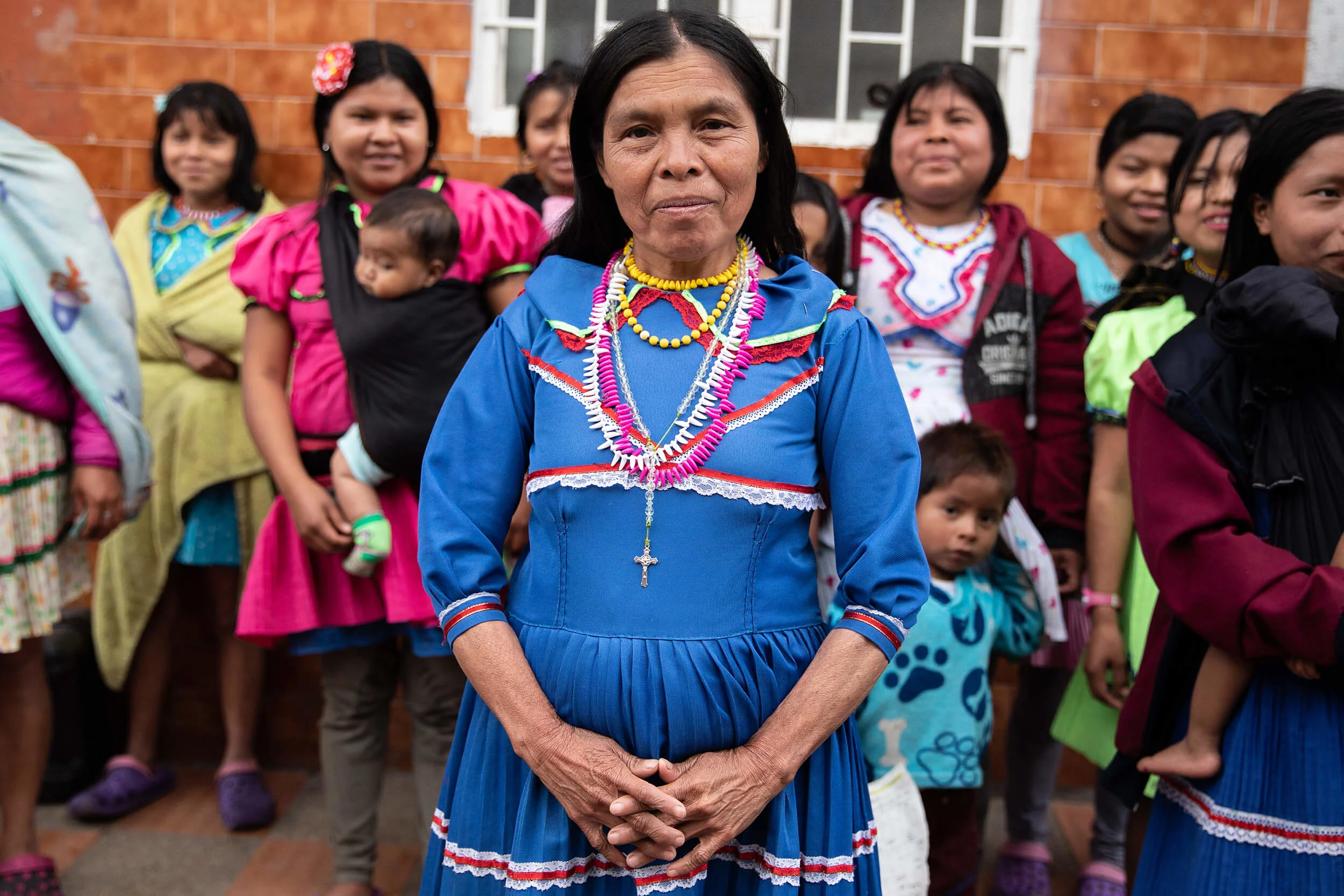
Beginning the resistance
With Abelardo’s murder, a defiant sense of unity had been awakened in the community.
The following week the Embera demanded answers. They claimed Abelardo’s blood was on the negligent hands of the authorities. Out on the streets they chanted, “Justice for Abelardo” while inside the leaning building Patricia mourned in desolation. Ever since the killing, shifts of young men kept guard duty outside of the paga-diarios.
Narciso Pitucay spent nights with his cousins on watch. His group was taunted daily by the denizens who wandered the streets of San Bernardo. Often he fought against outsiders who tried to muscle their way into the Embera homestead. Tensions almost boiled over again when a group of gang members drove past them with weapons drawn, shouting death threats. With police presence token at best, Narciso was unwavered and kept guard. He refused to be displaced again.
With Abelardo’s murder, a defiant sense of unity, long buried under years of bureaucratic prevarications and indifference, had been awakened in the community. The Embera vowed to protect themselves on the streets and in their homes. They rallied around their leaders who promised to take the issue to the authorities and resolve it once and for all.
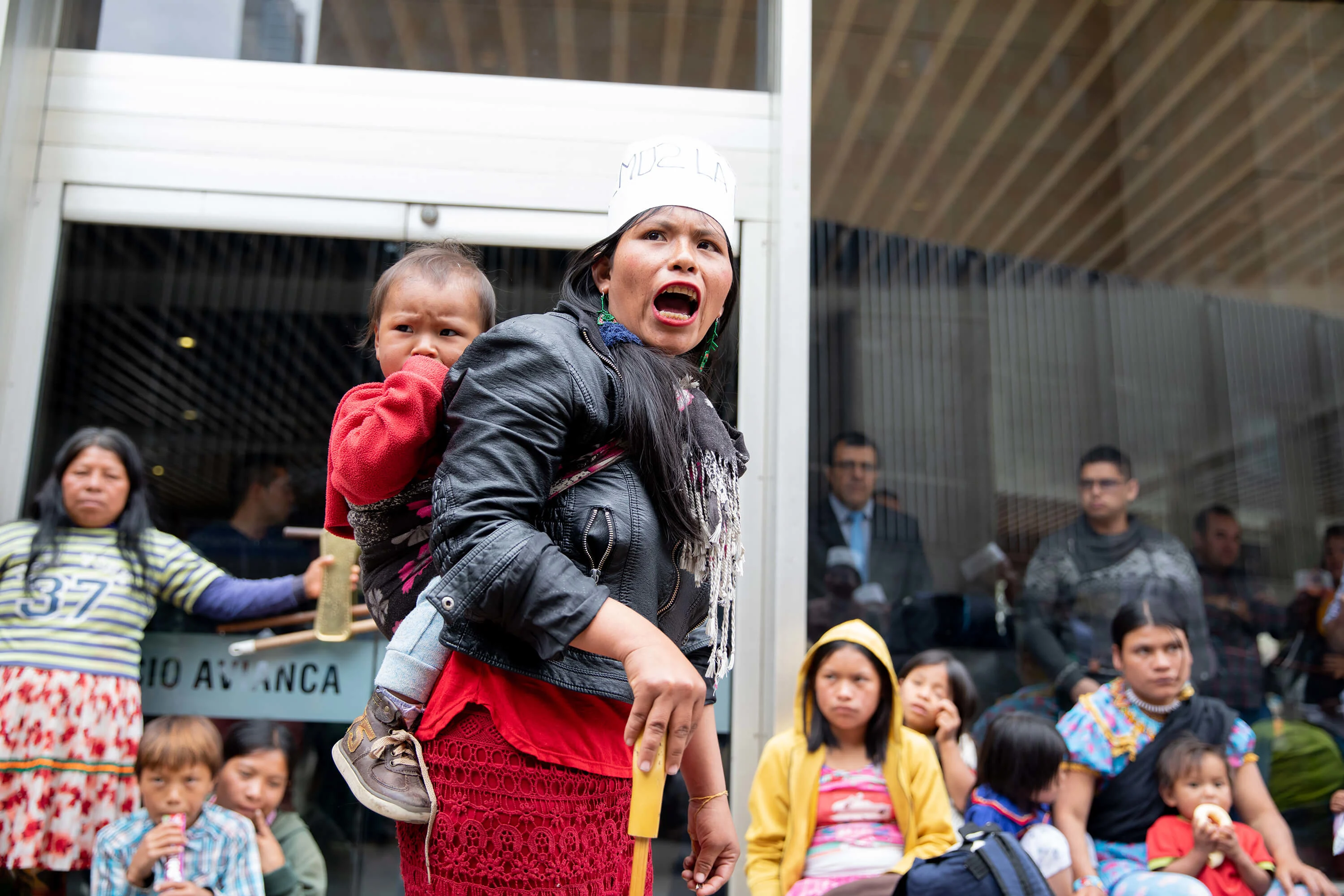
Direct Action
On the morning of September 6, two weeks after the murder, the rickety hallways of the decrepit San Bernardo block ran a little quieter. The bustle of 400 people waking for school, work and struggle made for a predictable crescendo of ruckus that peaked at 7am. That day was different. Elders stayed with the little ones while their parents marched on Bogotá’s political district. The community was done being threatened in the ramshackle homes that were supposed to be temporary, a decade into their displacement. The leaders recalled that the war came to them, not the other way around. Jesus Sintua, a fiery leader and veteran organizer, spoke as they headed to the protest: “ We will make ourselves known today and every other day until we get what is ours: peace and dignity for our people!”
Their target was the Victims Reparation Unit (VRU) in Bogotá’, the institution charged with providing for victims of the conflict. Once they got there, Embera women surrounded the offices with a sit-in while a group of leaders, including Fernando, marched to the offices of VRU to negotiate. The women held signs demanding justice for Abelardo, and supplies for the children and claimed they would occupy the congested plaza until they got an answer. With hundreds of Embera outside, the director of the VRU had no choice but to listen to the leaders grievances.
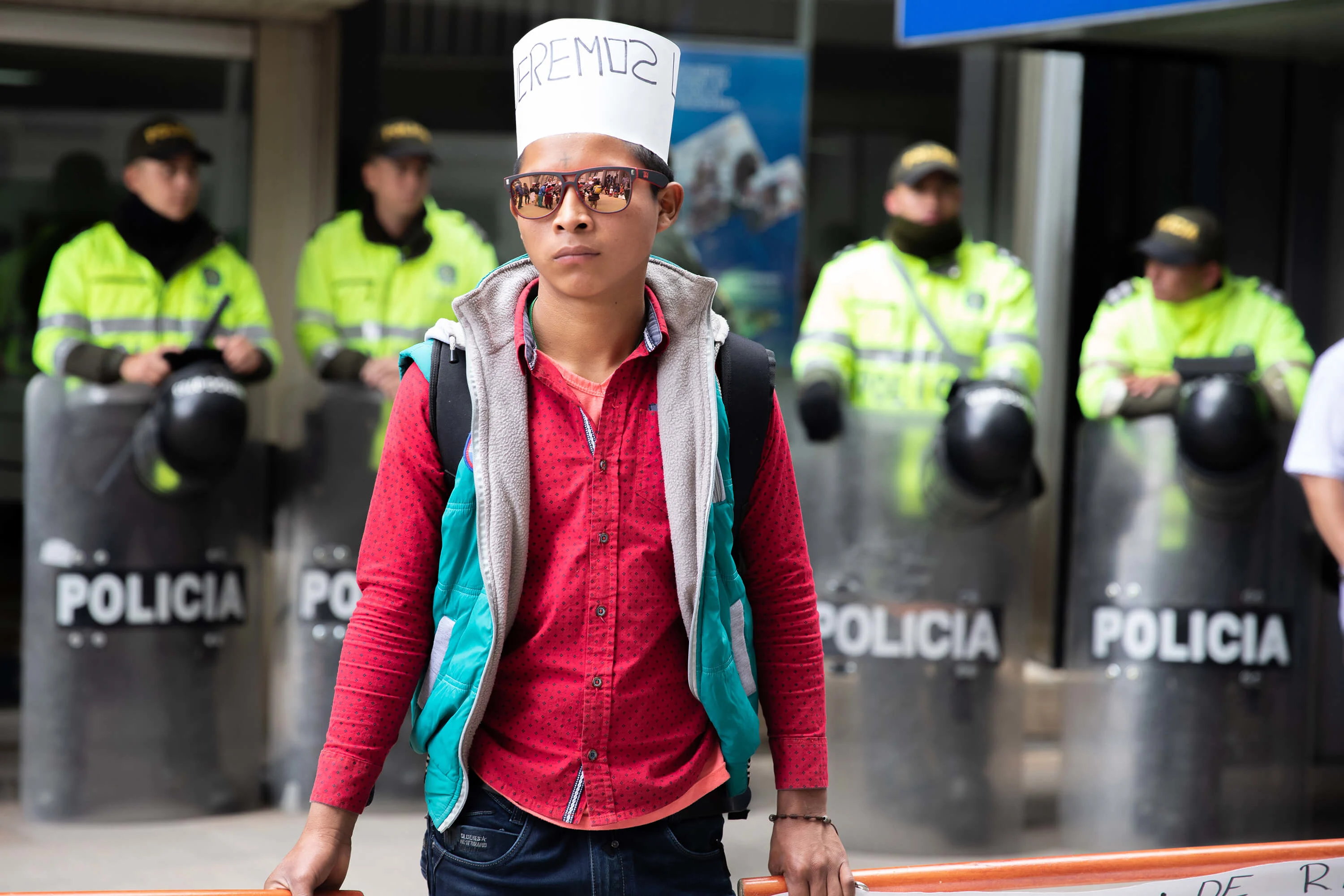
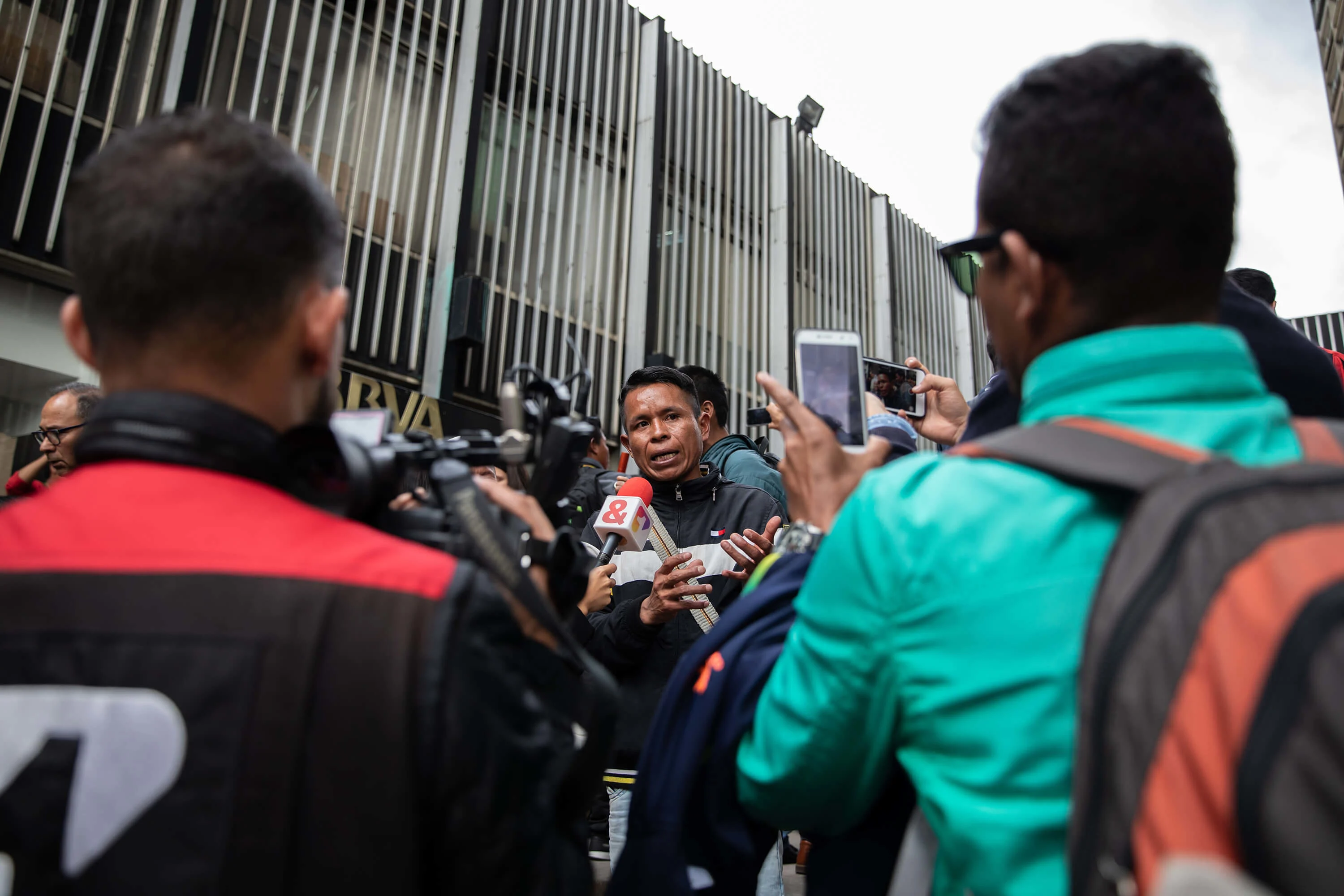
Their requests were simple: their priority was to return home with the guarantee of state protection. In the meantime, they needed to be relocated to different housing as San Bernardo was no longer safe. After the murder of Abelardo, armed men in blacked out cars kept circling the building calling for the leaders’ heads as recently as hours before the march. At first, the Embera wanted to make a stand to show they weren’t afraid. But in consulting as a community, the leaders decided it was time to abandon the paga-diario for the safety of their people.
While negotiations took place on the top floor of the prominent downton building, the women of the San Bernardo tenements added pressure of their own on the ground floor. Dressed in their traditional outfits, they sang songs in Embera and stood their ground. They also wore makeup used during holy ceremonies signifying the importance of the protest. Back in the apartment, the elders packed their belongings and marched with the young swaddled to their bodies. They were leaving the ghostly corridors of the criminal district behind for good and made their way to join the protest.
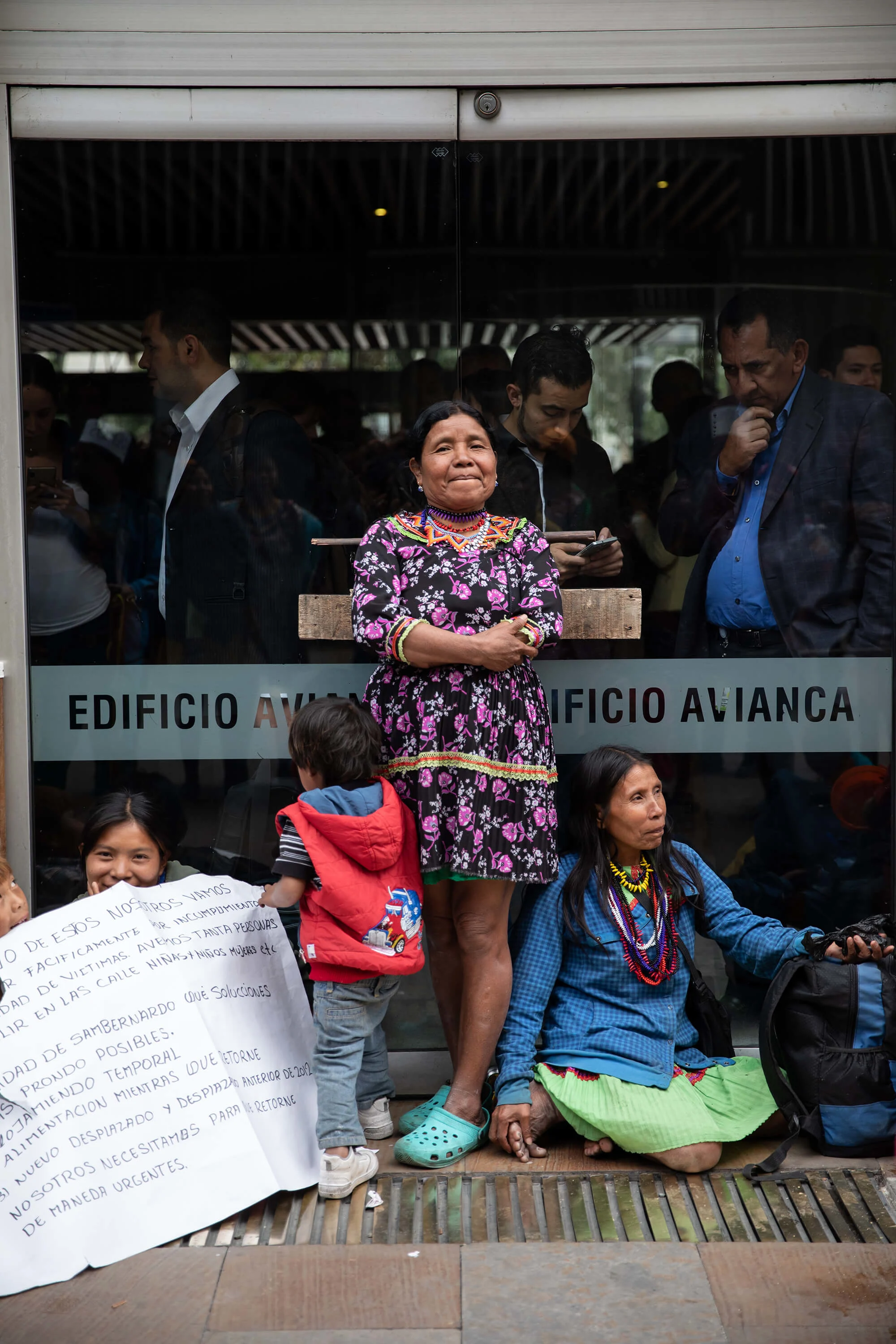
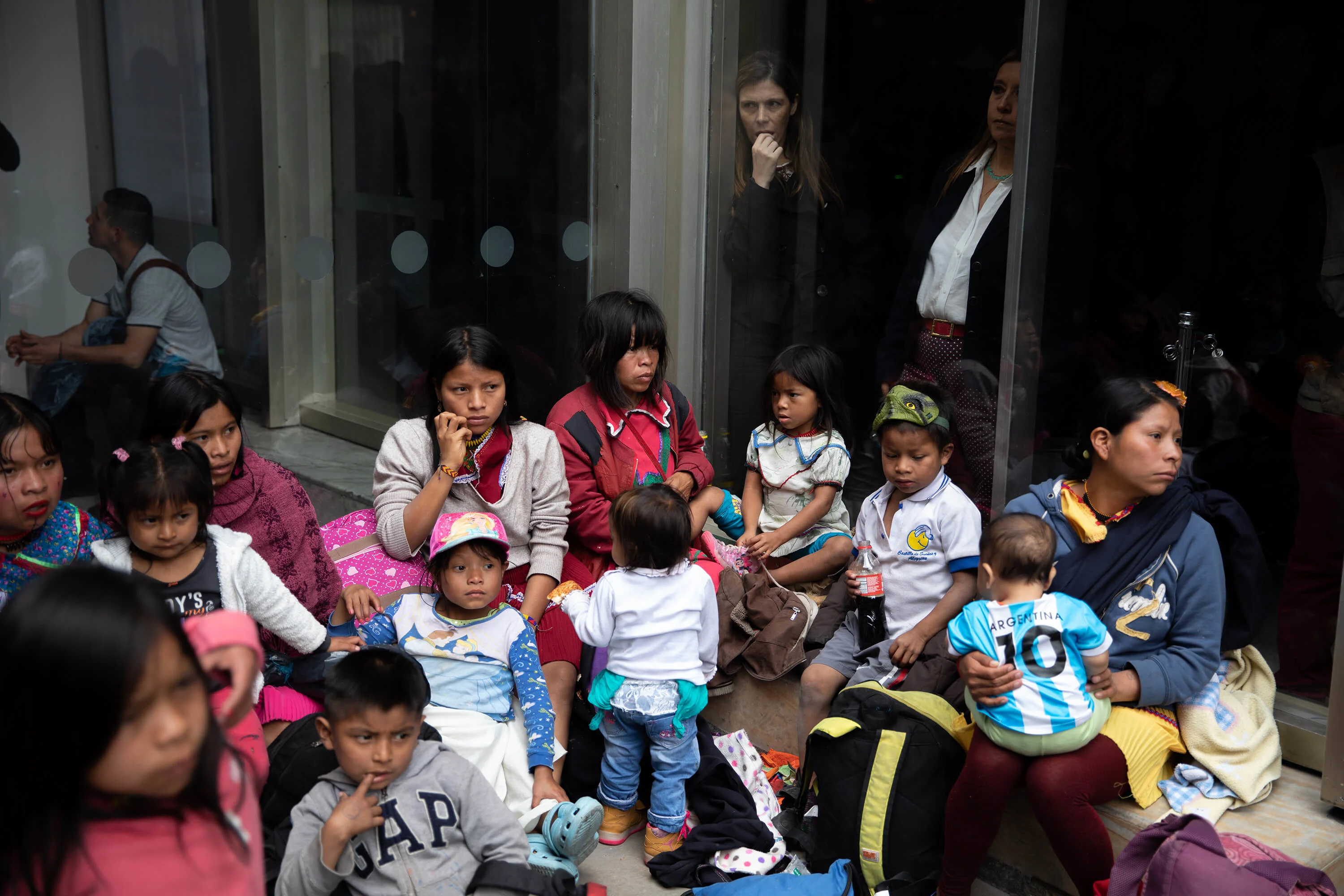
The Embera community was able to fight because they were united. They never gave up.
Under the shade of the building, over two hundred displaced men, women and children were amassed. For 30 minutes they held steady. When a signal was given - spread through a language older than Spanish itself - women blockaded the doors and bolted them with the sticks of their signs. The office was completely shut down with 4000 people locked inside. The move forced the city to pay attention to their plight and take the VRU to task. It was then, finally, that the leaders were granted their oft postponed meeting.
During the protest police tried to dislodge them, but the Embera’s resilience and resolve halted their attempts. Hours passed and with mounting pressure the VRU office gave in: the Embera secured their return. The community was going to be temporarily relocated to an encampment outside the city within the following days and after three months they would go back to their home territories. The doors were opened and out came the office workers and leaders. Fernando beamed, and hugged everyone in sight. After a decade of displacement, the communities of Choco and Risaralda were finally going home.
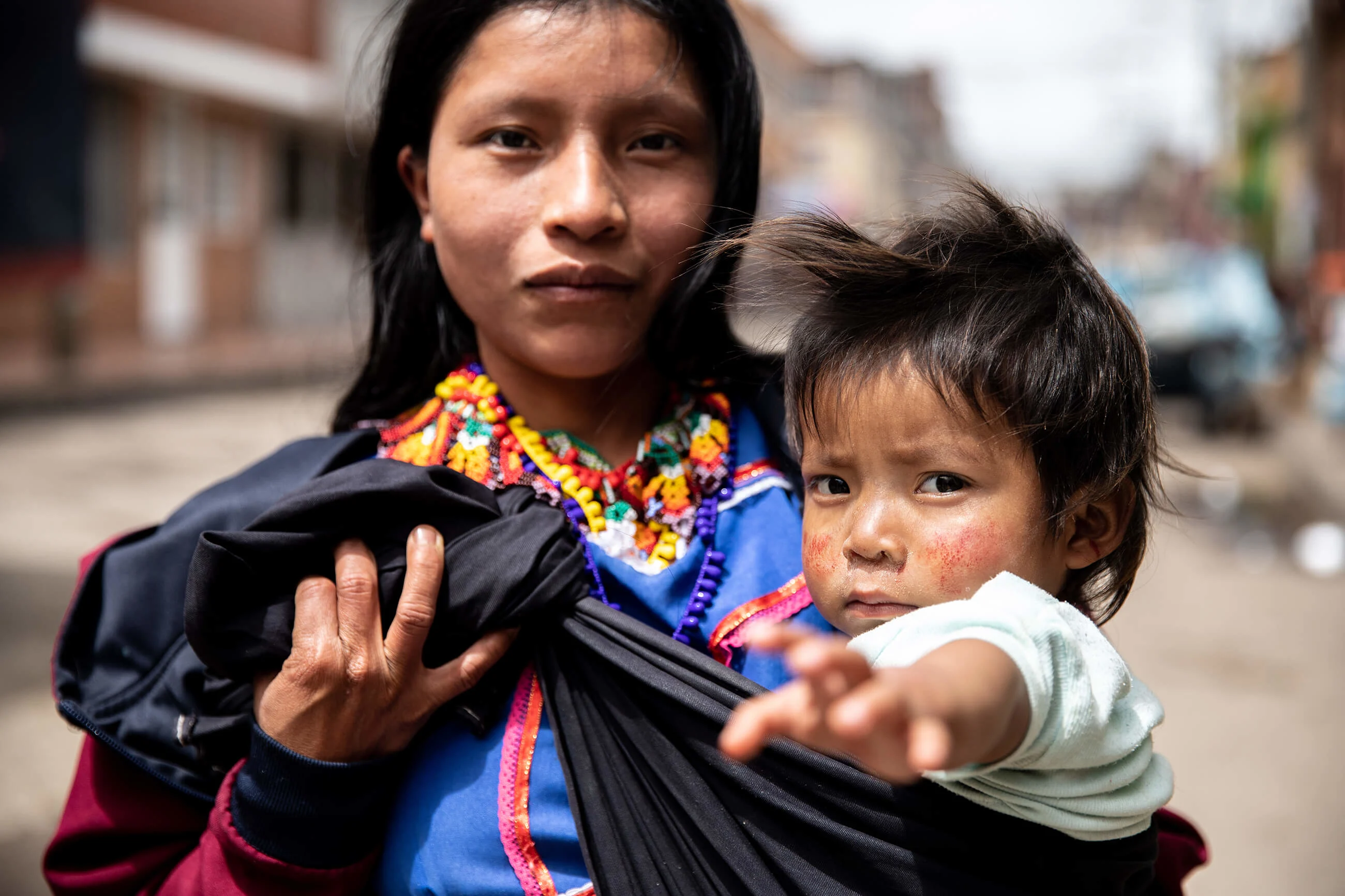
Success
Despite the state’s negligence through the years and the misery and danger that was bestowed on them by their neighbors, the Embera never lost hope, and never lost the bonds of love that held their families together. In plainest terms: the Embera had endured five centuries of attempted destruction and yet they persisted. These decades of struggle culminated in the resolution of their displacement, outlasting the war that was once thought to be without end. Even though there’s still fighting and displacement in pockets around the country, the old days of full scale combat are over. And in Bogota, the infamously overcrowded tenement of the dangerous San Bernardo neighborhood is no more.
The Embera community was able to fight because they were united. They never gave up because they shared food, pooled money, and organized their survival collectively. In every moment, mothers spoke of resistance to their daughters, fathers taught their sons their true language, and elders voiced reason so that Embera identity could survive in the most unlikely corner and thrive when they went back home. From mid-2018 to the first half of 2019, the relocation to their territories where their ancestors are laid to rest, and where their children will one day raise families, was a success. Fernando, Mirian, William, Soledad and Miguel, and nearly every one of the 1500 Embera from Choco and Risaralda who trickled into the capital over the course of a decade, now have peace in their home, and can pick up where they left off when their lives were interrupted.

